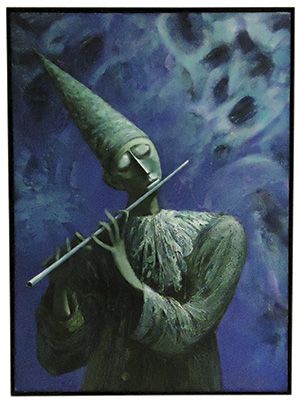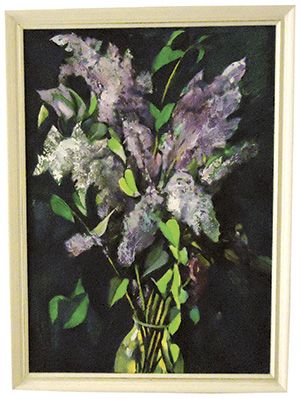
Yuri Makarov paints to gain self-identification
Over 20 paintings are on show, from among those held by the artist’s family, and by the National Centre of Contemporary Arts of the Republic of Belarus, as well as those held by private collectors. This year, Yuri Makarov would have celebrated his 60th birthday. His life was filled with dramatic creative freedom, and distinctive character, which we see in his works. He sought always to find life’s meaning: a theme close to the hearts of artists in the 1990s.
Yuri Makarov found self-identification through art, and attained considerable stylistic diversity as a result, producing various incarnations of his thinking. Yet, all are identifiable as his works. Olga Noskova, the curator of the exhibition, and a magister of art history and research officer of the National Art Museum’s Department of Contemporary Belarusian Art, tells us, “Yuri Makarov’s portraits are known for their special decorative character and open palette, which is typical of Belarusian portraiture from the 1970-1980s. He generalised characteristics at a formal, visual and associative level, while using colour, expression and texture well, as we see in his Tamara (1989), which depicts his wife, and in his Portrait of Larisa (2000) and in those of his sons (1986 and 2000).”
 |  |
His Lilac series attempts to hear the voice of nature, to speak its language and feel its expressiveness. Makarov’s melodies and rhythms are obvious in his formal compositions, with the image of a flute and flautist recurring. As an ancient instrument and a popular image in art through the ages, the flute symbolises man’s connection with nature, and the antagonism between good and evil: the searching of our soul. Makarov’s flautists make us stop and listen to the music inside us, reminding us that spring is, primarily, a state of the soul.
 |  |
MT REFERENCE:
Yuri Makarov (08.01.1956 — 2002) was born in the Arkhangelsk Region’s Velsk (Russian Federation).
In 1981, he graduated from the Painting Department of the Belarusian State Theatre and Art Institute (now, the Belarusian State Academy of Arts).
From 1984, he participated in art exhibitions. His diploma paper, In the Studio (a group portrait of young Belarusian painters), was awarded the highest mark and was exhibited at the All-Union Exhibition of Works by Young Artists, hosted by the USSR Academy of Arts (Moscow).
Yuri Makarov viewed Mai Dantsig, Chaim Livshits and Nikolay Zalozny as his inspiration.
From 1988, Yuri Makarov was a member of the Union of Artists of the USSR.
From 1981-1989, he taught at the Painting Chair of the Art Department at the Belarusian State Theatre and Art Institute.
Yuri Makarov’s works are kept by the Belarusian Union of Artists, the National Art Museum of the Republic of Belarus, the Culture Ministry, the National Museum of History and Culture of Belarus, the National Centre of Contemporary Arts, the State Museum of Nature and Ecology, Polotsk’s Historical and Cultural Museum-Reserve, the Russian Culture Ministry, regional picture galleries in Vologda and Pskov (Russia), and in private collections in Belarus and abroad.
By Veniamin Mikheev











